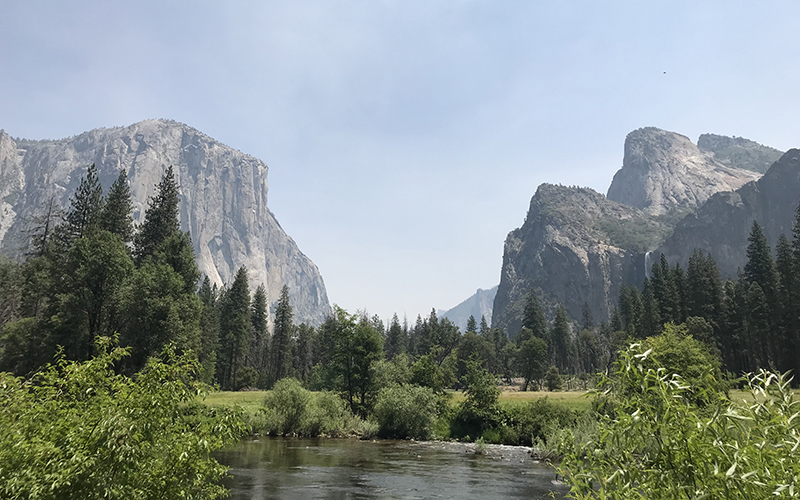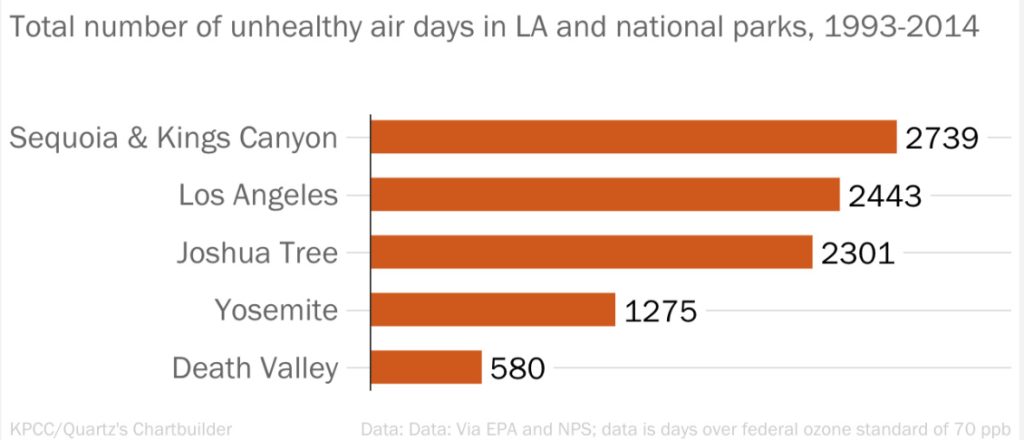
Haze is common at Yosemite National Park, as seen in this June photo, due to natural and prescribed fires in the park. Since mid-July, the nearby Ferguson fire has burned nearly 40,000 acres, sending plumes of ash and smoke into Yosemite Valley. (Cronkite News file photo)
LOS ANGELES – Mountains. Forests. Starry nights. Smog.
Smog? Sadly, yes. The air in two popular national parks in California is as dirty as it is in Los Angeles – the smoggiest city in the country.
“When you think of national parks, you think of these as being really pristine areas, almost areas you want to go to get out of cities,” said David Keiser, an economist at Iowa State University, who co-authored new research published earlier this month in Science Advances. “But in many ways, the air quality conditions are just the same there as they are in cities today.”
Forest fires don’t help the air quality. The Ferguson fire has burned through tens of thousands of acres of terrain near Yosemite National Park for two weeks, and it has forced officials to shut down parts of the park.
A park ranger said haze isn’t unusual at Yosemite because fires – whether wild or prescribed – are common in the park. But this month’s closures is the largest in nearly three decades, according to an article in The New York Times.
The dirt on dirty air
From 1993 to 2014, Los Angeles racked up 2,443 days in which air quality was so bad it violated federal safety standards for smog, also called ground-level ozone.
But Sequoia and Kings Canyon National Parks – a wonderland of rocky cliffs, icy mountain lakes and gigantic trees just east of Fresno – had even more smoggy days: 2,739.
Joshua Tree National Park was almost as bad, with 2,301 days.

“It’s a common misperception that because a place is labeled as a national park, there’s boundaries erected around it that prevent air pollution,” said Stephanie Kodish, head of the clean-air and climate program at the National Parks Conservation Association. There aren’t.
Where the pollution comes from
Both parks are downwind of the most air-polluted area in the country.
In Joshua Tree, the pollution blows in all the way from the Los Angeles Basin.
In Sequoia and Kings Canyon, it comes from big farms in the Central Valley and cities such as Bakersfield, Fresno and the San Francisco Bay Area.
Smog – ground-level ozone and airborne particulates – forms when sunlight reacts with a volatile organic compound and nitrogen oxide from vehicle exhaust, power plants and factories. Volatile organic compounds are common in household products and fuels.
But in cities, air quality improves overnight. It doesn’t as much in nature, said Annie Esperanza, the air-resources specialist for Sequoia and Kings Canyon National Parks.
In urban areas during the day, nitrogen-oxide emissions contribute to smog. But at night, with the absence of sunlight, nitrogen oxide switches sides to help break down ozone, so that by morning, the air is cleaner.
But in national parks and other less-populated areas, there aren’t as many sources of nitrogen oxide around at night to break down the ozone. That’s because there are fewer people driving, so smog lingers day and night.
For healthy adults, high levels of ozone can make it hard to breathe, cause wheezing or respiratory infections.
One study found that breathing smoggy air for a day or two increased the risk of heart attacks for middle-aged adults without heart disease. And many studies have found hospital visits for heart and lung problems go up on days when air pollution is bad.
It’s even worse for kids and the elderly.
Fading from view
Beyond the health effects, smoggy days in national parks are just a bummer because they make it harder to see the epic vistas that attracts visitors.
Esperanza said on a clear day, you should be able to see more than 100 miles from an overlook on Sequoia and Kings Canyon’s steep, winding entrance road.
“When visibility is obscured, you can maybe see 25 to 30 miles,” she said.
Know before you go
The parks with the worst air quality try to warn visitors about air quality through Twitter handles, such as @SequoiaKingsAir.
You also can check air quality here. Just enter the name of the park you want to to visit, or click on it on the map, and real-time air-quality data will pop up.
These warnings may be working, because the researchers found that fewer people visit parks on smoggy days.
“It turns out a 1 percent increase in ozone levels results in a 1 percent decrease in visitation,” Keiser said.
Is the air quality improving in national parks?
Yes, but not as quickly as in other places.
Since the early 1990s, Los Angeles and other cities have made huge gains in cleaning up the air. But air pollution in national parks remains stubbornly bad.
Keiser, the Iowa State researcher, and his co-authors found that between 1993 and 2014, the average number of bad air days in U.S. cities fell from 53 to 18 days a year. Meanwhile, the number of smoggy days in national parks didn’t fall as much: from 27 in 1993 to 16 in 2014.
That means, as of 2014, national parks were nearly as smoggy as U.S. cities.
Part of the reason for the slower progress in national parks is that, for a long time, regulatory agencies weren’t focused on parks. A 1999 EPA regulation called the Regional Haze Program requires states to clean up the air in national parks, but it didn’t take effect until 2007, so there just hasn’t been as much time for things to improve.
“You have a longer history of targeting sources of pollution that have an effect on public health,” Kodish said. “It’s more recent that there have been targeted efforts to clean up pollution that’s harming parks.”
In other words, things that improve air quality for people living in cities – like forcing big emitters such as refineries to install modern pollution controls – may not work for the rural places where smog gets carried.
This story is part of Elemental: Covering Sustainability, a new multimedia collaboration between Cronkite News, Arizona PBS, KJZZ, KPCC, Rocky Mountain PBS and PBS SoCal.
Follow us on Twitter.